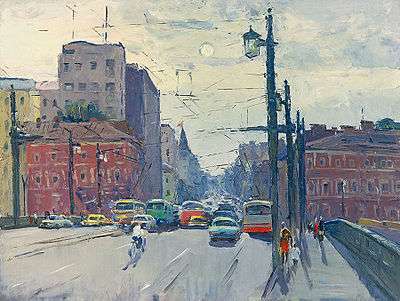Liteyny Bridge
Coordinates: 59°57′07″N 30°20′58″E / 59.951980°N 30.349406°E
| Liteyny Bridge Лите́йный мост | |
|---|---|
 | |
| Coordinates | 59°57′7.13″N 30°20′58.22″E / 59.9519806°N 30.3495056°E |
| Carries | 6 lanes of roadway, tram lines |
| Crosses | Neva River |
| Locale | Saint Petersburg |
| Characteristics | |
| Design | Segmental bridge, bascule bridge |
| Total length | 396 meters |
| Width | 34 meters |
| Longest span | 55 meters |
| History | |
| Opened | 1879, October 1 |
The Liteyny Bridge (Russian: Лите́йный мост) is the second permanent bridge across the Neva river in Saint Petersburg, Russia. It connects Liteyny Prospekt with Vyborgsky district. The bridge's length is 396 meters, the width is 34 meters. At the vicinity of the Liteyny Bridge, the Neva river reaches the maximum depth of 24 meters.
History
The ancient maps reveal that even before the city was founded, there was a crossing on the way from Russia to Sweden approximately at the location of the modern bridge. At one bank of the river the road from Novgorod was ending, and at another bank the road to Vyborg was starting.
The decision to build a permanent bridge was made after rough ice destroyed the temporary floating bridge on April 4, 1865. Even though similar events have happened in the past, this particular one caused strong reaction from the government, and special expert commission was created. But it took until 1869 to agree on the location for the bridge. On April 22, 1871 the open contest was declared, and total of 17 projects were submitted. As a result of the contest, the project under the Vestminster banner was chosen by the city authorities. However the transport ministry rejected it and created the expert commission of its own and declared a winner to be engineer colonel A. Struve who was one of the members of the commission.
The building of the new bridge started on August 30, 1875. The work conditions were difficult, and during the next four years there were two fatal accidents which caused death of 14 people. The official opening ceremony took place on October 1, 1879. Struve was promoted to the rank of Major General.

The bridge is named Liteyney which literally means Foundry after the Liteyny Prospekt and Liteyny district which in turn were named after big foundry which was established on the left bank in 1711. In 1903 the bridge was renamed Aleksandrovsky in name of tzar Alexander II. But this name was never adopted by the public and after the October Revolution in 1917 the original name Liteyny Bridge was restored.
Soon after the opening, the bridge was equipped with electrical lights - the invention of Russian inventor Pavel Yablochkov. It was the first bridge to get electrical lighting and for the long time it remained the only one, since the monopoly of gas producers in city opposed it. On the picture you actually see Alexander Nevsky bridge.
References
- ↑ Sergei V. Ivanov. Unknown Socialist Realism. The Leningrad School.- Saint Petersburg: NP-Print Edition, 2007. – P. 153, Plate 129. - P. 450. ISBN 5-901724-21-6, ISBN 978-5-901724-21-7.
External links
- "Liteyny Bridge", 1982 by Alexander Semionov at STVBACCHUS Album
Liteyny Bridge in Art
- "Liteyny Bridge", 1982, by Leningrad artist Alexander Mikhailovich Semionov (1922 - 1984)